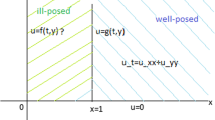Abstract
In a one-dimensional heat conduction domain with heated and insulated walls, an integral approach is proposed to estimate time-dependent boundary heat flux without internal measurements. It is assumed that the expression of the heat flux is not known a priori. Hence, the present inverse heat conduction problem is classified as a function estimation problem. The spatial temperature distribution is approximated as a third-order polynomial of position, whose four coefficients are determined from the heat fluxes and the temperatures at both ends at each measurement. After integrating the heat conduction equation over spatial and time domain, respectively, a simple and non-iterative recursive equation to estimate the time-dependent boundary heat flux is derived. Several examples are introduced to show the effectiveness of the present approach.
Similar content being viewed by others
Abbreviations
- C :
-
Heat capacity per unit volume [j/m3-K.]
- k :
-
Thermal conductivity [W/m-K]
- l :
-
Length [m]
- Q :
-
Non-dimensionalized heat flux, q/qo[-]
- q :
-
Boundary heat flux [W/m2]
- qo :
-
Reference boundary heat flux [W/m2]
- R :
-
Random number ranging-0.5 ≤ R ≥ 0.5 [-]
- T :
-
Non-dimensionalized temperature [-]
- T* :
-
Temperature [K]
- T i :
-
Initial temperature [K]
- T L :
-
Non-dimensionalized temperature at the left end [-]
- T r :
-
Non-dimensionalized temperature at the right end [-]
- t :
-
Non-dimensionalized time,at*/1 2 [-]
- t* :
-
Time [s]
- u(t) :
-
Unit step function,u(t) =0 fort>0,u(t)=l fort≥0 [-]
- x :
-
Non-dimensionalized coordinate,
- x*l [-]x* :
-
Coordinate [m]
- α:
-
Thermal difTusivity [m2/s]
- ΔT:
-
Error level [-]
References
Daouas, N. and Radhouani, M. -S., 2000, “An Extended Version of the Discrete Kalman Filter Applied to a Nonlinear Inverse Heat Conduction Problem,”International Journal of Thermal Sciences, Vol. 39, pp. 191–212.
Hills. R. G. and Hensel, Jr., E. C, 1986. “One- Dimensional Nonlinear Inverse Heat Conduction Technique,”Numerical Heat Transfer, Vol. 10. pp. 369–393.
Huang, C.-H. and Üzişik, M. N., 1991, “Direct Integration Approach for Simultaneously Estimating Temperature-Dependent Thermal-Conductivity and Heat-Capacity,”Numerical Heat Trans-fer-A, Vol. 20, pp. 95–110.
Huang, C.-H. and Wang, S. -P., 1999, “A Three-Dimensional Inverse Heat Conduction Problem in Estimating Surface Heat Flux by Conjugate Gradient Method,”International Journal of Heat and Mass Transfer, Vol. 42, pp. 3387–3403.
Jung, B. S., Kim, S. K., Kim, H. J. and Lee, W. I., 2001, “Inverse Estimation of Thermal Properties for APC-2 Composite,”Transactions of KSME-B, Vol. 25, pp. 673–679.
Kim, S., 2001, “A Simple Direct Estimation of Temperature-Dependent Thermal Conductivity with Kirchhoff Transformation,”International Communications in Heat and Mass Transfer, Vol. 28. pp. 537–544.
Lee, W. -S., Ko, Y. H. and Ji, C. -C, 2000, “A Study of an Inverse Method for the Estimation of Impulsive Heat Flux,”Journal of the Franklin Institute, Vol. 337, pp. 661–671.
Shenefelt, J. R., Luck, R. Taylor, R. P. and Berry, J. T., 2002, “Solution to Inverse Heat Conduction Problems Employing Singular Value Decomposition and Model-Reduction,”International Journal of Heat and Mass Transfer, Vol. 45, pp. 67–74.
Author information
Authors and Affiliations
Corresponding author
Rights and permissions
About this article
Cite this article
Kim, S., Kim, MC. & Youn Kim, K. A direct integration approach for the estimation of time-dependent boundary heat flux. KSME International Journal 16, 1320–1326 (2002). https://doi.org/10.1007/BF02983839
Received:
Revised:
Issue Date:
DOI: https://doi.org/10.1007/BF02983839




